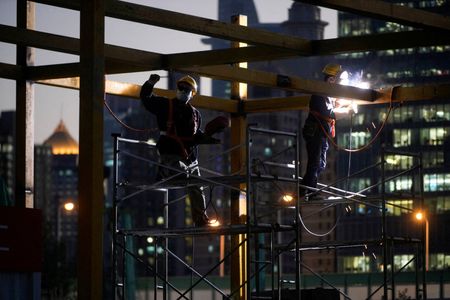By Ellen Zhang and Joe Cash
BEIJING (Reuters) -Profits at China’s industrial firms contracted further in the January-November period as strict COVID 19-related curbs disrupted factory activity and supply chains, but analysts foresaw brighter long-term economic prospects after a U-turn in COVID policy.
Industrial profits fell 3.6% in January-November from a year earlier to 7.7 trillion yuan ($1.11 trillion), according to data released by the National Bureau of Statistics (NBS) on Tuesday. That compares with a 3.0% drop for January-October. No standalone data was released for November.
Zhu Hong, a senior NBS statistician, highlighted a rebound in COVID outbreaks and lacklustre demand in November that curbed industrial production and placed increasing pressure on Chinese businesses, according to a statement from the bureau.
Analysts have noted a squeeze in profits both from anti-virus curbs in big manufacturing hubs such as Guangzhou and Zhengzhou, and from the persistent weight of a protracted property crisis and slowing exports.
But they expect a robust recovery could kick in next year as the economy reopens, although for the near term there was likely to be a further slump as the removal of restrictions brings a sharp rise in infections.
Last month, industrial output rose only 2.2% from a year earlier, missing expectations for a 3.6% gain in a Reuters poll and slowing significantly from the 5.0% growth seen in October.
Despite Beijing ditching some of the world’s toughest anti-virus restrictions in early December, and on Monday announcing it would end quarantine requirements for inbound travellers from Jan. 8, the economy is still expected to struggle over the winter months as much of the population becomes infected and unable to work while recovering.
Industrial profits could fall further in December with many cities facing a surge in COVID infections, said Hao Zhou, chief economist at GTJAI.
He added that strong improvement is highly likely from next January, however, as economic activity returns to normal, and called for robust and targeted policies to help revive private-sector firms in the year ahead.
JP Morgan analysts said China’s domestic reopening, which came earlier and faster than expected, would mean a shorter period of transitional pain in the first quarter of 2023, followed by an above-trend sustained recovery from the second quarter.
Earlier this month, they trimmed their forecast for China’s year-on-year GDP growth rate for the current quarter, to 2.2% from 2.7%, but raised their full-year growth forecast for next year, to 4.3% from 4%.
For January-November, profits at private-sector firms shrank 7.9%, a slight improvement from the 8.1% fall in the first 10 months.
Profits fell for 21 of 41 major industrial sectors, with the ferrous metals smelting and pressing industry suffering the steepest decline, at 94.5%. That compares with a 92.7% fall for the first 10 months.
Profits for manufacturers were down 13.4% in the first 11 months, matching the fall in January-October.
Business confidence in China has fallen to its lowest level since January 2013, a survey showed last week, reflecting the impact of surging COVID cases on economic activity.
At this year’s closed-door Central Economic Work Conference, top leaders and policymakers pledged to step up policy adjustments to support the slowing economy.
China’s economic growth was just 3% in the first three quarters of this year and is expected to stay around that rate for the full year, one of its worst years in almost half a century.
Industrial profit data covers large firms with annual revenues above 20 million yuan from their main operations.
($1 = 6.9601 Chinese yuan renminbi)
(Reporting by Ellen Zhang and Joe Cash; Editing by Edmund Klamann)

